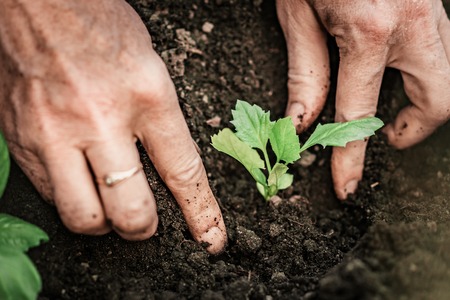Understanding Your Soil Type
If youre dreaming of a healthy and productive backyard garden, the first step is getting to know your soil. In the U.S., most backyards fall into one of four main soil types: clay, loam, sand, or silt. Each type affects how well plants grow and how water moves through the ground. Knowing what kind of soil you have helps you make better decisions about planting, watering, and improving your garden space.
Common Soil Types in American Backyards
Heres a quick look at the characteristics of each soil type:
| Soil Type | Texture | Water Retention | Drainage | Impact on Plants |
|---|---|---|---|---|
| Clay | Sticky and dense when wet; hard when dry | High | Poor | Can lead to root rot if not managed; holds nutrients well |
| Loam | Soft, crumbly, and balanced feel | Moderate | Good | Ideal for most plants; retains moisture while draining well |
| Sand | Gritty and loose | Low | Excellent | Dries out quickly; needs frequent watering and fertilizing |
| Silt | Smooth and floury when dry; slippery when wet | Moderate to High | Fair to Poor | Nutrient-rich but may compact easily, affecting root growth |
How to Identify Your Soil Type at Home
The Jar Test Method:
- Scoop some soil from your yard and remove any debris like roots or rocks.
- Place the soil into a clear glass jar until its about 1/3 full.
- Add water until the jar is nearly full and shake it well.
- Let it sit for 24 hours. Youll see layers form—sand settles at the bottom, then silt, then clay.
- The proportions help you determine your dominant soil type.
The Squeeze Test:
- Dampen a small amount of soil in your hand.
- Squeeze it into a ball.
- If it holds its shape and feels sticky, its likely clay. If it falls apart right away, its sandy. If it holds together but crumbles easily, its loamy.
Why Knowing Your Soil Type Matters
Your soil’s texture affects how roots grow, how water drains (or doesn’t), and how nutrients are held in place. For example, sandy soils need more frequent watering and fertilizing because they drain quickly. Clay soils hold nutrients but can suffocate roots if too compacted. Loamy soils offer the best of all worlds—a balanced mix that supports strong plant growth with minimal fuss.
Tip:
If youre unsure about your results or want more precise info, many local Cooperative Extension Services offer affordable soil testing kits or lab analysis tailored for your region.
Understanding your backyard soil is the foundation of building a thriving garden. Once you know what youre working with, you’ll be able to improve it step by step.
2. How to Test Soil Health
Understanding your backyard soil is the first step toward creating a thriving garden. Testing your soils health doesnt have to be complicated or expensive. With just a few tools and a bit of time, you can learn about your soil’s pH, nutrient levels, and organic matter content. This information helps you make smarter decisions about what to plant and how to amend your soil.
Why Soil Testing Matters
Your soils health directly impacts plant growth, water retention, and nutrient availability. Without testing, its hard to know what your plants are really getting from the ground. A simple test can reveal if your soil is too acidic or alkaline, lacking in key nutrients like nitrogen or phosphorus, or low in organic material that supports healthy microbes.
DIY Soil Test Kits
For most backyard gardeners, DIY soil test kits are an easy and affordable option. These kits are widely available at garden centers or online and usually include tests for:
- pH Level: Measures acidity or alkalinity
- Nitrogen (N): Important for leafy growth
- Phosphorus (P): Encourages root and flower development
- Potassium (K): Supports overall plant health
How to Use a DIY Kit:
- Collect a sample from several spots in your garden and mix them together.
- Follow the instructions on the kit—usually involves mixing soil with water and adding testing solution.
- Compare the color change against the chart provided.
Professional Lab Testing
If youre looking for more detailed results, consider sending a sample to a local extension service or agricultural lab. This is especially helpful if youre planning a large garden or suspect serious imbalances in your soil.
What Labs Can Test For:
| Test Type | What It Tells You |
|---|---|
| Soil pH | The acidity/alkalinity level of your soil |
| Nutrient Levels (N-P-K) | The amount of essential macronutrients available to plants |
| Organic Matter Content | The percentage of decomposed plant/animal material improving soil structure and fertility |
| Cation Exchange Capacity (CEC) | The soil’s ability to hold onto essential nutrients |
When to Test Your Soil
The best time to test is either in early spring before planting or in fall after harvesting. Avoid testing immediately after fertilizing as it may skew the results.
Tips for Accurate Testing
- Use clean tools and containers when collecting samples.
- Avoid areas near compost piles, driveways, or pet activity zones.
- If sending to a lab, follow their sampling instructions carefully.
Did You Know?
Many state universities offer low-cost lab testing through their Cooperative Extension programs. Just search “soil testing + [your state]” to find local options.
With the right tools and approach, testing your backyard soil can be simple and rewarding—giving you valuable insights that lead to healthier plants and better harvests.

3. Improving Soil Fertility Naturally
Healthy, fertile soil is the foundation of a thriving backyard garden. Many American home gardeners turn to natural methods to boost soil fertility without relying on synthetic chemicals. Techniques like composting, mulching, planting cover crops, and using organic soil amendments not only improve soil structure but also help support beneficial microbes and earthworms that are essential for healthy plant growth.
Composting: Turn Kitchen and Yard Waste into Garden Gold
Composting is one of the easiest and most effective ways to enrich your soil naturally. By recycling kitchen scraps and yard waste, you create nutrient-rich humus that improves soil texture and boosts microbial activity.
What You Can Compost
| Greens (Nitrogen-rich) | Browns (Carbon-rich) |
|---|---|
| Fruit & veggie scraps | Dried leaves |
| Coffee grounds | Shredded newspaper |
| Grass clippings | Sawdust (untreated wood) |
A good rule of thumb is to mix greens and browns in a 1:2 ratio. Keep your compost moist like a wrung-out sponge and turn it every couple of weeks to speed up decomposition.
Mulching: Lock In Moisture and Feed the Soil
Mulch acts as a protective layer over your soil. It helps retain moisture, suppress weeds, regulate temperature, and slowly breaks down to feed the soil. Organic mulches are preferred by many U.S. gardeners because they decompose over time and add nutrients back into the earth.
Common Organic Mulch Materials
- Bark or wood chips (great for pathways and around trees)
- Straw or hay (ideal for vegetable gardens)
- Dried grass clippings (use in thin layers to avoid matting)
- Pine needles (excellent for acid-loving plants like blueberries)
Add 2–3 inches of mulch around your plants, making sure not to pile it against stems or trunks, which can cause rot.
Cover Crops: Grow Green Manure
Certain plants grown specifically to improve soil are called cover crops or green manure. These crops are planted during the off-season or between growing cycles. They prevent erosion, add organic matter, fix nitrogen, and improve soil aeration when turned back into the ground before flowering.
Popular Cover Crops in the U.S.
| Name | Main Benefit | When to Plant |
|---|---|---|
| Clover | Nitrogen fixation | Late summer or early fall |
| Buckwheat | Adds organic matter quickly | Summer |
| Austrian winter peas | Nitrogen fixer and winter hardy | Late fall |
Mow or till cover crops into the soil a few weeks before planting your main crops to allow decomposition and nutrient release.
Organic Soil Amendments: Feed Your Soil the Natural Way
If your backyard garden needs a little extra boost, organic amendments can help balance nutrients naturally. Unlike synthetic fertilizers that act fast but fade quickly, organic materials release nutrients slowly over time while improving soil health.
Common Organic Amendments Used by American Gardeners
| Name | Main Nutrients | Description |
|---|---|---|
| Composted manure (cow, horse, chicken) | Nitrogen, phosphorus, potassium (NPK) | Adds rich nutrients and improves texture; must be well-aged to avoid burning plants. |
| Bone meal | Mainly phosphorus | Powers strong root development; ideal for bulbs and root vegetables. |
| Kelp meal or seaweed extract | ||
| Lime (garden lime) |
The key with amendments is to test your soil first so you know what it really needs—too much of any one nutrient can throw off the balance. Once you know your soil’s profile, apply amendments as directed on packaging or based on local extension service recommendations.
4. Maintaining Long-Term Soil Health
Keeping your backyard soil fertile over the long run takes more than just one-time fixes. To truly sustain healthy soil year-round, you’ll want to adopt seasonal care routines, rotate your crops wisely, and steer clear of practices that strip your soil of nutrients.
Seasonal Soil Care
Each season brings different needs for your soil. By adjusting your care techniques throughout the year, you can maintain a thriving underground ecosystem that supports strong plant growth.
| Season | Soil Care Tips |
|---|---|
| Spring | Add compost or organic matter, test pH levels, and prepare beds for planting. |
| Summer | Mulch to retain moisture and suppress weeds, monitor watering needs, and avoid compaction. |
| Fall | Incorporate cover crops like clover or ryegrass to prevent erosion and add nutrients. |
| Winter | Protect bare soil with mulch or leaf litter, and avoid walking on wet soil to prevent damage. |
Crop Rotation Strategies
Certain plants pull specific nutrients from the soil while others help replenish them. Rotating crops each year helps balance nutrient levels and prevents pests from settling in. Heres a simple rotation plan you can follow:
| Year | Crop Type | Examples |
|---|---|---|
| 1 | Leafy Greens | Lettuce, spinach, kale |
| 2 | Fruiting Vegetables | Tomatoes, peppers, cucumbers |
| 3 | Root Crops | Carrots, beets, radishes |
| 4 | Legumes (Nitrogen Fixers) | Peas, beans |
Avoiding Soil-Depleting Practices
Certain habits can harm your soil’s health over time. Avoid these common mistakes to keep your garden growing strong:
- Tilling too often: It breaks up soil structure and kills beneficial organisms.
- Overusing chemical fertilizers: They can cause salt buildup and reduce microbial activity.
- Leaving soil bare: Exposed soil is prone to erosion and nutrient loss.
- Poor drainage: Waterlogged soil can suffocate roots and lead to compaction.
Nurturing Soil Life Year-Round
Your soil is alive with microorganisms that support plant health. Keep them happy by feeding the soil regularly with organic matter like compost, using natural mulches, and minimizing disturbance. Healthy microbes help break down nutrients and improve overall fertility—making your garden more productive season after season.
A Quick Checklist for Ongoing Soil Health:
- Add compost twice a year (spring and fall).
- Mow or cut cover crops before they flower.
- Avoid stepping on garden beds when wet.
- Mulch around plants during summer heat.
- Test your soil every few years to track changes.
Sustaining fertile backyard soil isn’t hard—it just takes a little planning through the seasons. With good habits in place, your garden will reward you year after year.
5. Common Soil Problems and Solutions
Many American homeowners run into similar soil issues in their backyards that can affect plant growth and garden success. Understanding these common problems—and how to fix them—can make all the difference for a healthy, productive yard. Below are typical soil challenges and practical solutions tailored for residential gardening.
Soil Compaction
What it is: Compacted soil occurs when the soil particles are pressed tightly together, leaving little space for air, water, or roots to move through.
Common signs: Water puddles on the surface after rain, stunted plant growth, hard ground that’s difficult to dig.
Solutions:
- Aerate your soil: Use a manual or mechanical aerator to loosen compacted areas.
- Add organic matter: Mix in compost or leaf mold to improve structure and allow better root penetration.
- Avoid walking on garden beds: Use stepping stones or paths to reduce pressure on growing areas.
Poor Drainage
What it is: Soil with poor drainage holds water too long, which can suffocate roots and promote rot or fungal diseases.
Common signs: Standing water after rain, yellowing leaves, wilting despite moist soil.
Solutions:
- Create raised beds: Elevate planting areas to help excess water drain away.
- Add sand or gravel: Mix into clay-heavy soils to improve drainage (in moderation).
- Install drainage systems: French drains or perforated pipes can help move water away from problem areas.
Erosion
What it is: Erosion happens when wind or water removes topsoil, which is often the most fertile layer of your yard.
Common signs: Exposed roots, bare patches of ground, noticeable soil movement after storms.
Solutions:
- Plant ground covers: Use plants like creeping thyme or clover to hold soil in place.
- Add mulch: Spread wood chips or straw to protect topsoil from being washed or blown away.
- Create terraces on slopes: Build level planting steps to slow down water runoff on hillsides.
Nutrient Deficiency
What it is: A lack of essential nutrients like nitrogen, phosphorus, or potassium needed for healthy plant growth.
Common signs: Yellowing leaves, poor flowering or fruiting, weak stems.
Solutions:
- Test your soil: Use a home test kit or send a sample to your local extension office to identify missing nutrients.
- Add amendments based on results:
| Nutrient | Deficiency Sign | How to Fix It |
|---|---|---|
| Nitrogen (N) | Pale green or yellow leaves | Add composted manure or blood meal |
| Phosphorus (P) | Purple-tinted leaves, poor root growth | Add bone meal or rock phosphate |
| Potassium (K) | Browning leaf edges, weak stems | Add wood ash or greensand |
Poor Soil Structure
What it is: Soil that’s either too sandy (doesn’t hold nutrients) or too clay-heavy (holds too much moisture) can be hard for plants to thrive in.
| Soil Type | Description | Fixes |
|---|---|---|
| Sandy Soil | Loses water and nutrients quickly; feels gritty | Add organic matter like compost; use mulch to retain moisture |
| Clay Soil | Dense and sticky when wet; cracks when dry | Add compost and gypsum; avoid overwatering; aerate regularly |
| Silty Soil | Smooth texture but compacts easily | Add coarse sand and organic matter; avoid heavy foot traffic |
The Takeaway: Know Your Soils Needs
The key to solving common backyard soil problems is understanding what kind of soil you have and responding with targeted care. With a little effort and the right techniques, your backyard garden can thrive year after year.


